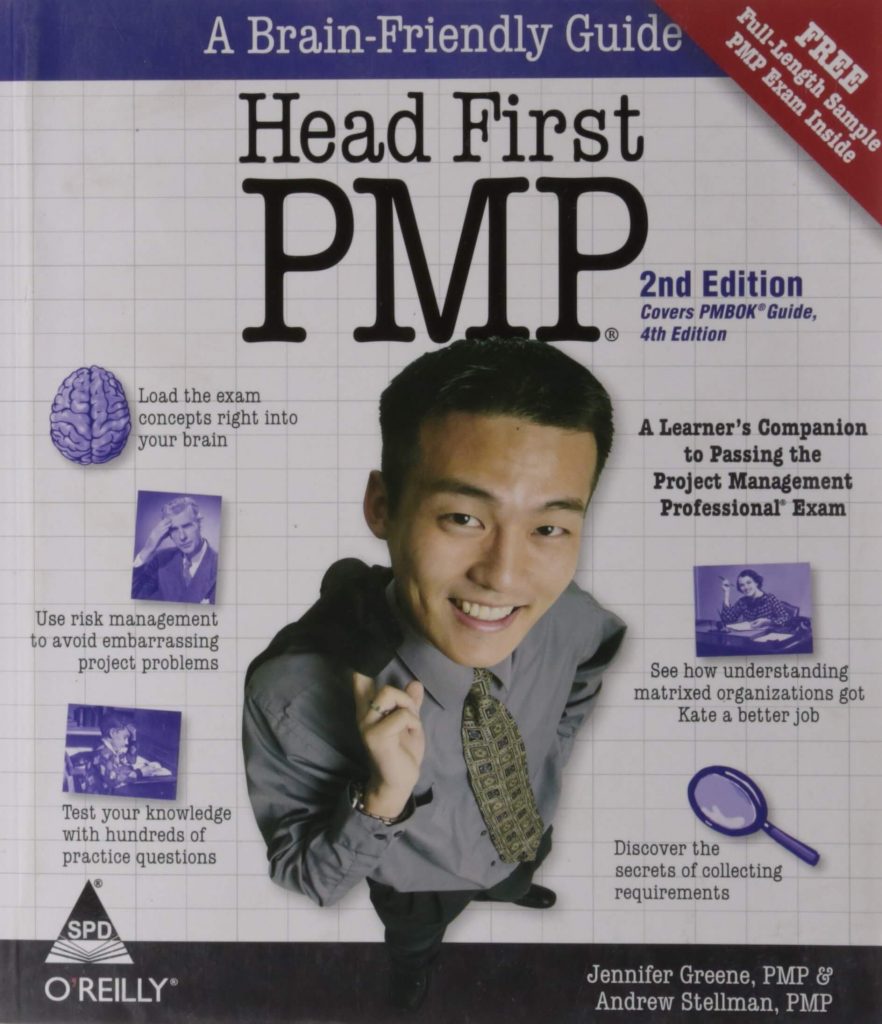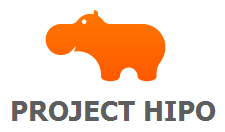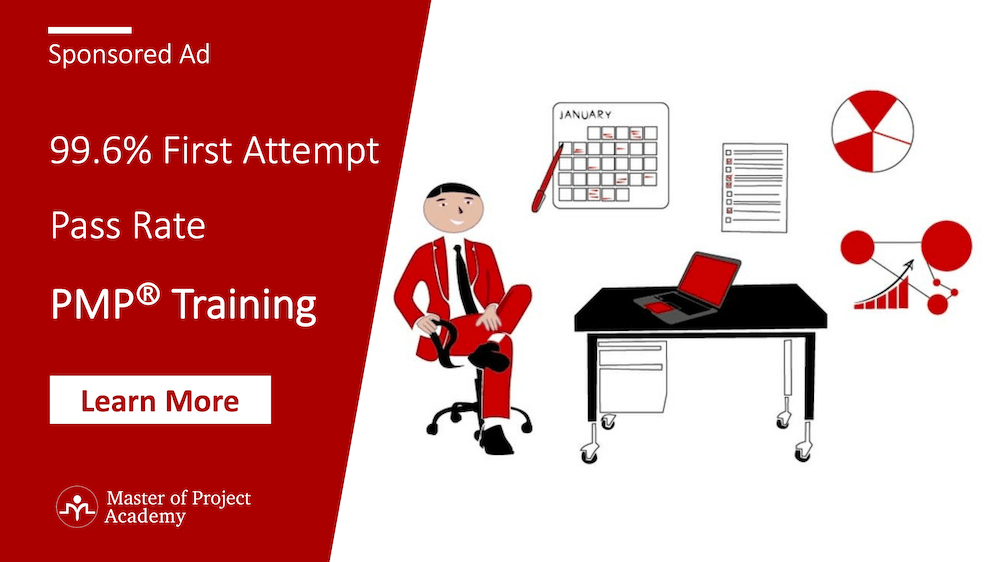In this article, we will review Head First PMP with its contents, salient features, and shortcomings of the latest Head First PMP-4th edition. Hence this article will help you to decide whether to choose this book i.e. Head First PMP or another book to prepare for the PMP exam.
As we are all aware that Project Management Professional (PMP) Certification is a world-recognized, most demanded certification in the area of project management. Main reference book to crack this certification is the PMBOK Guide. It is not an easy book to understand the concepts of the PMP exam. Hence there are different books used along with the main reference book to prepare for the exam. But one of the most popular PMP books that have been used for years by new aspirants to pass the PMP exam is Head First PMP.
What is Head First PMP?
Head First books came into existence in 2003 by Bert Bates and Kathy Sierra. This is a series of introductory instructional books to many topics such as Agile, C, HTML, Java, Software Development, Web Design, etc and last but not the least Head First PMP. Head First PMP was launched by Andrew Stellman and Jennifer Green. It is also known as Brain-Friendly Guide. There are many supporting books available in the market. But one of the main reasons why Head First PMP became popular is its way of representation of the concept in a pictorial form which helps a new aspirant to understand the subject in an easier manner.
O’Reilly established Head First Labs where series of books were presented in an easy to understand way. Likewise, Head First PMP is also written in an engaging manner. This book uses simple language which is easy to understand and has a flavor of fiction. Also, it makes use of numerous diagrams, charts, and figures to simplify the topic.

Insight Into Head First PMP
Each chapter of Head First PMP starts with a story which is used as a center point for explaining the topics. Further, they give details on the topics via a series of small examples and anecdotes based on the starting story. Also, there are crosswords, short exercises and fill in the blanks which help an aspirant to remember the concepts well. At the end of each chapter of the Head First PMP, sample PMP questions make you revise the chapter thoroughly.
Head First PMP is written in a very casual manner which helps in understanding the topics easily. However, it gives the impression that the level of PMP exam is not tough. On the contrary, the structure is very different from the main reference guide i.e. PMBOK Guide. However, this book can be used by people who are new to project management because they can get an overview of project management in simpler terms. In fact, Head First PMP can be a stepping stone for novice managers. But it needs to be used in conjunction with PMBOK Guide and some other reference book to pass the exam.
Salient Features of Head First PMP
- Firstly, Head First PMP teaches you the latest principles of The PMBOK Guide in a unique and inspiring way.
- Secondly, it is not in a traditional format of book but offers a visual format to help you grasp the big picture of project management
- Thirdly, Head First PMP has a unique way of presenting PMP Concepts into context. Hence, it will help the candidate to understand, remember and apply them on the exam as well on the job.
- Then, Head First PMP has good coverage of the latest principles and objectives in The PMBOK Guide, Sixth Edition
- Another reason to choose Head First PMP is the availability of hundreds of practice questions and exam strategies.
- Further then, lots of puzzles, games, problems, and exercises are available to make learning easier.
- Easy to digest and entertaining book to learn PMP concepts.
You can read our Best PMP Training post to see all PMP training options and ratings.
What makes it different from others?
- Head First PMP makes use of visually rich format than heavy text approach in other books to engage your mind. Hence it makes use of multi-sensory learning approach designed for the brain.
- They don’t make use of lecture mode. Instead, Head Fist PMP presents the concept via story using simple language.
- Also, this book makes use of visuals as it is a fact that visuals are more memorable than words. Hence it makes learning more fun and effective.
- Head First PMP book makes use of attention-grabbing tactics by introducing graphics in a little humorous and surprising way.
- Each page has a combination of text and graphics. Further, you won’t find 2 pages whose layout is the same because the page layout is dynamic.
- Another peculiar feature of Head First PMP book is that they make use of redundancy which means saying the same things in different ways with different media types. So it increases the chance to get content coded in more than one area of your brain
- Usage of Concepts, Pictures, Exercises, games and fun examples with emotional content in Head First PMP to make brain remember more appropriately.
- High quality of instructional design that provides easy learning.
- Head First PMP makes use of personalized, conversational style.
- They use multiple learning styles which means the same content represented in multiple ways.
- This book provides memory joggers, hints, tips and tricks for attempting PMP questions.

PMP Exam preparation with Head First PMP
Head First PMP is one of the most popular books used by aspirants since its onset. It has evolved over the years and the latest edition of Head First PMP that is compliant to PMBOK-6th edition is Head First PMP-4th edition. Exam content of PMP keeps on changing, so it requires extensive study of material, book along with practice questions. These days online content is gaining importance. However, books cannot lose their importance because “OLD is Gold”. So they still have importance and in good demand in the market. Moreover, one book that is most in-demand and tops the charts is Head First PMP. Now we will see what is in this Head First PMP Book.
Content outline of the book:
- Introduction
- The Organizational Environment
- The Process Framework and Project manager’s role
- Integration Management- This knowledge area is based on “Getting the job done”
- Scope Management- This knowledge area is based on “Doing the right stuff”
- Schedule Management- This knowledge area is based on “Getting it done on time”
- Cost Management- This knowledge area is based on “Watching the bottom line”
- Quality Management- This knowledge area is based on “Getting it right”
- Resource Management- This knowledge area is based on “Getting the team together”
- Communications Management- This knowledge area is based on “Getting the word out”
- Risk Management- This knowledge area is based on “Planning for the unknown”
- Procurement Management- This knowledge area is based on “Getting some help”
- Stakeholder Engagement: This knowledge area is based on “Keeping everyone engaged”
- A little last-minute review: This is based on “Check your knowledge”
- Practice makes perfect: Practice PMP Exam.
Topics covered in Head First PMP are:
Introduction Section: Why get certified?
- Why a person should get certified.
- What are the unique characteristics of a good project manager?
- Project lifecycle models such as Predictive, Adaptive, Iterative, Incremental, Hybrid and tailoring.
- Distinguish between Project, Programs, and Portfolios.
- Distinguish between what a PROJECT is and what a Project is NOT.
- Defining of “A day in the life of a project manager”
- How Project Managers run great projects
- Types of Project Management Office (PMO)- Supportive, Controlling and Directive
- Leadership skills
- Project Team
- Operations Management
- Meet a Real-life PMP Certified project manager
The Organizational Environment
- A day in Kate’s Life
- Kate wants a new Job
- Different Types of Organizational Structures
- Project Manager power
- Managing Project Constraints
- Kates takes a new job by working in an organic organization
- Acceptance Criteria
- Organization Processes
- Organization Magnets Solution
Process Framework and Project Manager’s Role
- Cooking up a project
- Projects are like recipes
- The project can be managed in phases if the size is big
- Phases can overlap
- Process Magnets
- Anatomy of a Process
- Knowledge area organizes the processes
- Knowledge Area Magnets and Solutions
- The Project Manager’s Role
- Your technical skills make successful projects happen
- Leadership is different than management
- Styles of Leadership
- Types of Power of Project Manager
- Benefits of successful Project management
- Exam Questions and Answers
Project Integration Management
- Illustration to book a trip where teachers are thrilled but clients are not satisfied ultimately
- Day to Day work of a project manager
- A Birds-eye view of a project
- Seven Integration Management Processes
- Start your project with Initiating Process
- Integration Management and Process Groups
- The Develop Project charter process
- Plan your project
- Project Management Plan lets you plan ahead
- Subsidiary plans
- The Direct and Manage Project Work Process
- The Project team creates deliverables
- Executing the project includes repairing defects
- The Manage Project Knowledge process
- Changes, Defects and Corrections
- Control your changes
- Preventing or correcting problems
- Finish the work
- Close the project
- Exam Questions
Scope Management
- Power of Scope Management
- The Six Scope Management Processes
- Plan your scoping process
- Collect requirements for your project
- Talk to your stakeholders
- Understand your requirements
- Stakeholders know a lot about your project already
- Use a questionnaire to get requirements from a bigger group of people
- A prototype shows users what your product will be like
- Now you are ready to write a requirements document
- Define the scope of a project
- How do you define the scope?
- The Project scope statement tells you what you have to do
- Create the work breakdown structure
- The inputs for WBS come from other processes
- Breaking down the work
- Decompose deliverables into work packages
- The project scope baseline is a snapshot of the plan
- The outputs of Create WBS process
- Why scope changes
- The Control Scope Process
- Anatomy of a change
- A closer look at the change control system
- Control Scope Tools and Techniques
- Make sure the team delivered the right product
- The stakeholders give you the criteria for deciding when you are done
Schedule Management
- Schedule Management helps with aggressive timelines
- Plan your scheduling processes
- Use the Define Activities process to break down the work
- Tools and Techniques for Define Activities
- Rolling Wave Planning lets you plan as you go
- Define activities outputs
- The Sequence Activities process puts everything in order
- Diagram the relationship between activities
- Network Diagram put your task in perspective
- Dependencies help you sequence your activities
- Leads and Lags add time between activities
- Scheduling software can help you see the sequence of activities
- Create the network diagram
- Figuring out how long the project will take
- Estimation tools and techniques
- Create the duration estimate
- Use the critical path method to avoid a big problem
- How to find the critical path
- Finding the float for any activity
- Float tells you how much extra time you have
- Figuring out the early start and early finish
- Figuring out the latest possible start and latest finish
- Add early and late durations to your diagrams
- Fast-tracking the project
- Use data analysis techniques when you build your schedule
- Other Develop Schedule tools and techniques
- Outputs of Develop Schedule
- Influence the factors that cause a change
- Control Schedule Inputs and Outputs
- Measuring and reporting performance
- Control Schedule tools and techniques
- Exam Questions
Cost Management
- Time to expand Head First Kitchen
- The renovation goes overboard
- Introducing the Cost Management processes
- Plan how you will estimate, track and control your costs
- Now you have got a consistent way to manage costs
- What Alice needs before she can estimate costs
- Other tools and techniques used in Estimate Costs
- Let’s talk numbers
- Now Alice knows how much the kitchen will cost
- The Determine Budget Process
- What you need to build your budget
- Determine the budget: how to build a budget
- The Control costs process is a lot like schedule control
- Look at the schedule to figure out your budget
- How to calculate the planned value
- Earned value tells you how you are doing
- How to calculate earned value
- Is your project behind or ahead of schedule?
- Are you over budget?
- The earned value management formulas
- Interpret CPI and SPI numbers to gauge your project
- Forecast what your project will look like when it’s done
- Once you have got an estimate, you can calculate a variance
- Finding missing information
- Keep your project on track with TCPI
- A High TCPI means a tight budget
- Exam Questions
Quality Management
- What is Quality?
- “ An ounce of Prevention”
- Plan quality is how you prevent defects
- How to plan for quality
- Quality Management Plan
- Use the planning outputs for Control Quality
- Tools for Data Gathering
- Tools for Data Analysis
- Inspection, testing, and product evaluation
- Control Quality
- Trouble at Black Box factory
- Introducing Managing Quality
- Fireside Chats
- Exam Questions and Answers
Resource Management
- Mike needs a new team, Get your team together and keep them moving
- Figure out who you need on your team
- A closer look at Plan Resource Management Outputs
- The Resource Management Plan
- What you need to estimate resources
- Estimating the resources
- Get the team together
- Develop your team with management skills
- Your interpersonal and team skills can make a big difference for your team
- Lead the team with management skills
- Motivate your team
- Stages of team development
- Manage your team
- Conflict Management
- How to resolve a conflict
- The output of Control Resources Process
- Exam Questions and Answers
Communications Management
- Party at the Head First Lounge
- Anatomy of communication
- Get a handle on communication
- Let everyone know how’s a project going
- Take a close look at the work being done
- Now you can get the word out
- People aren’t talking
- Count the channels of communication
- It’s party time
- Exam Questions and Answers
Risk Management
- What’s a risk?
- How do you deal with risk?
- Plan Risk Management
- Use a risk breakdown structure to categorize risks
- Anatomy of a risk
- What could happen to your project?
- Data gathering techniques for Identify Risks
- Where to look for risks
- Now put it in the risk register
- Rank your risks
- Examine each risk in the register
- Qualitative vs Quantitative Analysis
- Perform Quantitative Risk Analysis
- First, gather the data
- Calculate the expected monetary value of your risks
- Decision tree analysis uses EMV to help you make choices
- Update the risk register based on quantitative analysis results
- How do you respond to risk?
- Add risk responses to a register
- Implement Risk Responses
- Risk responses can find even more risks
- Risk Management exposed
- Monitor Risks
- More Control Risk Tools and Techniques
- Exam Questions and Answers
Procurement Management
- Victim of her own success
- Calling in the cavalry
- Agreement Process Magnets and solutions
- Ask the legal expert
- Anatomy of an agreement
- Start with a plan for the whole project
- Make or Buy Magnets
- Type of Contractual Agreements
- Fixed Price Contracts
- Cost reimbursable Contracts
- Time and Materials
- Figure out how you will sort out potential sellers
- Get in touch with potential sellers
- Pick a partner
- Keep an eye on the contract
- Stay on top of the seller
- Kate closes the contract
- Exam Questions and Answers
Stakeholder Management
- Party at the Head First Lounge
- Understanding your stakeholders
- Find out who your stakeholders are
- How engaged are your stakeholders
- Managing stakeholder engagement
- Monitor your stakeholder engagement
- Pool Puzzle and solution
- It’s party time
- Exam Questions and Answers
Professional Responsibility
- Doing the right thing
- Keep the cash?
- Fly business class?
- New software
- Shortcuts
- A good price or clean river?
- We’re not all angels
- Exam Questions and Answers
A little last-minute review
- Process Magnets and answers
- A long term relationship for your brain
- Integration and overall PMBOK Questions and answers
- Scope Questions and answers
- Schedule Questions and answers
- Cost Questions and answers
- Quality Questions and answers
- Project Resource Questions and answers
- Communications Questions and answers
- Risk Questions and answers
- Procurement Questions and answers
- Stakeholder Questions and answers
Modes of Reading
Head First PMP book is available in Paperback format at amazon.com. And if you want to go for online reading then the Kindle version is also available.

Shortcomings of Head First PMP Book
- Content is not very much aligned with PMBOK Guide
For instance, in Head First PMP book under chapter Project Communications Management, it is mentioned that “According to PMBOK Guide, ninety percent of project management is communication”. But PMBOK Guide states that Project managers spent most of their time communicating.
- Little errors and contradiction in the content of this book
For instance, in Human Resource Management, Head First PMP book says that there are 5 kinds of power: legitimate, reward, expert, and referent. But only 4 powers are mentioned and counting as 5.
- Chapter names not aligned with PMBOK Guide latest version i.e. 6th Edition
In Head First PMP, processes are updated to match with PMBOK guide. However, chapters are still as per previous PMBOK Guide version. For Instance: Chapter Resource Management is mentioned as “Human Resource Management” in Head First PMP.
- Kindle version of Head First PMP book is very messy
Though Head First PMP is useful to prepare for the exam, the way it looks on the Kindle app is not at all acceptable. There is no zoom option. Features of this app are very limited.
Moreover, the layout of the book is different from the printed and PDF version.
- Coverage of content is less
If you compare coverage of PMP content then it is 85-90% only as per PMBOK Edition. Many of PMP topics are not covered in detail in Head First PMP. Hence there is a need to refer another book to cover the topic in detail.
- Level of questions are too easy
PMP exam is a mix of simple and complex direct and situational questions. In Head First PMP, questions’ level is generally on the easy side. Although, sample questions should be a blend of simple and complex.
How Can I Download Head First PMP?
Generally, candidates look for the free version of the book that can be downloaded from the internet.
Another way is to get a copy printed of someone known and make use of the book. But as per PMI code of ethics and professional conduct, it is not ethical and highly unprofessional to access a copy of licensed product without the permission of author so it is not recommended to do this.
Moreover, Head First PMP is a very low-cost book so can be easily purchased as a paperback or Kindle version. And the paperback book can be delivered to the desired address mentioned while ordering the book.
Customer Reviews:
“Good Book for basic understanding”
Head First PMP is good for building basic understanding but in no way sufficient for the exam. For the exam, you need to read PMBOK for at least 5 times and practice around 1500 sample questions without fail.
“An Innovative Alternative to PMBOK”
Job well done to authors Jennifer Greene and Andrew Stellman on creating another wonderful Head First Reference, this time for PMP Prep. I was dreading ordering the new PMBOK because of how poor the reviews were for formatting alone and it dawned on me that there might be a better alternative. I loved the format so much I gifted my copy to a colleague who is taking a PMP prep course and am ordering another for myself. Highly recommend Head First PMP book to those who want a more “brain-friendly” approach to PMP Prep.
“Good Buy”
It’s easy to understand and comprehend.
“Won’t help Pass PMP exam”
The book is written at a shallow level, questions are recalled ability question, won’t help in the PMP exam.
“Must have for pomp Prep”
Easy to understand PMP concepts and it really suited my style of learning
“Very Helpful, Great Book”
I am at the beginning of pursuing PMP Certification. The online course I am taking for my 35 contact hours recommended reading an exam prep book before starting the online course. I am glad I chose Head First PMP. It’s not a dry read at all. It’s very engaging and there are a variety of exercises and quiz styles to help you test your learning. My favorites were the end of chapter crossword puzzles. This book will keep you engaged and teach you a TON!
Summary
Head First PMP book was written by Jennifer Greene and Andrew Stellman. Till date, many versions have evolved with time in accordance with the main reference guide i.e. PMBOK Guide. Latest version used for Head First PMP is 4th edition in compliance to PMBOK Guide latest version i.e. 6th edition.
Head First PMP is written in a very simple language and it is easy to understand. Hence it is useful for beginners who want to have an overview of PMP concepts and project management. However, this book alone is not sufficient enough to prepare for the PMP exam. Especially the latest version has some small errors and contradiction and some of the topics of PMP exam are not covered in sufficient detail.
You can read our reviews about the most popular PMP programs:



